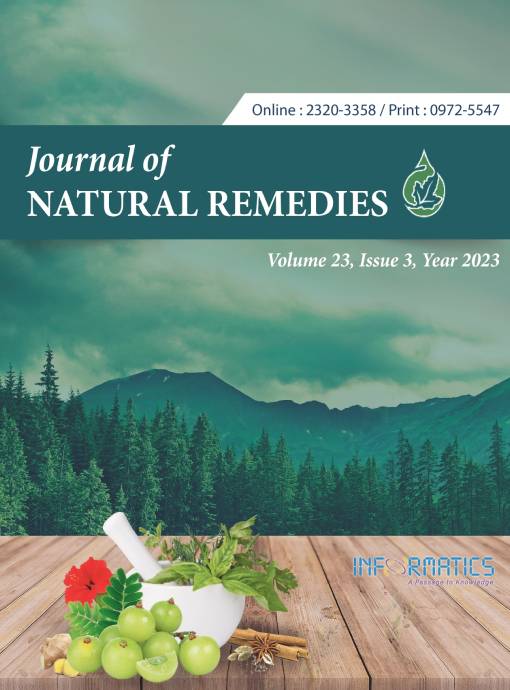Single Herbs and Diet Propagated by Classical Ayurvedic Texts for Improving ‘Gut Health’ as Indicated in Grahani (Irritable Bowel Syndrome) - A Review
DOI:
https://doi.org/10.18311/jnr/2023/32083Keywords:
Ahara, Ayurveda, Gut, Gut Biome, Irritable Bowel Syndrome, SamhitaAbstract
‘Gut’ is being referred to as ‘second brain’ as the role played by the gut is very crucial to health. In continuation, the gut microbiome is a part of gut health. Diet plays an important role in maintaining the healthy microbiome. A close correlation to gut health is found to Grahani mentioned in Ayurveda. The word ‘Grahani’ is used to specify the organ ‘Grahani’ correlated as duodenum and the disease ‘Grahani’ whose clinical presentation of alternating frequent watery bowels, and constipation blood-stained stools can be correlated to Irritable Bowel Syndrome (IBS). This disease is attributed to the pathology of the Annavaha srotas (channels carrying the food and the related organs). Even with medical intervention, Ahara (food) is to be planned with utmost care and sensitivity. In Grahani, the treatments and diet prescribed are meant for the healing and recovery of the alimentary tract, they are inclusive of the gut microbiome also. Hence a literature review of the Brhatrayis - the three major classical textbooks in Ayurveda: Charaka Samhita, Susruta Samhita and Ashtanga Sangraha and Hrdaya were reviewed for the single herbs and diet recommendations in Grahani. Articles supporting this fact from modern pharmacology were added as supporting documents. No review has been done so far exploring into the depths of the Ayurvedic Samhitas regarding the single herbs and diet mentioned to address gastric ailments thus relating to the gut and gut health. This article aims at filling this lacuna.
Downloads
Metrics
Downloads
Published
How to Cite
Issue
Section
License
Copyright (c) 2023 M. Sujithra, M. G. Minsha (Author)

This work is licensed under a Creative Commons Attribution 4.0 International License.
Accepted 2023-04-21
Published 2023-08-31
References
Vaghbhata. Ashtanga Sangraha. Sharma SP, ed. Varanasi: Chaukhambha Sanskrit Series Office; 2012: 301.
Vaghbhata. Ashtanga Hrdaya. Paradakara HSS, ed. Varanasi: Chaukhambha Sanskrit Sansthan; 2011: 497.
Bischoff SC. “Gut health”: A new objective in medicine? BMC Medicine. 2011; 9(1). https:// doi.org/10.1186/1741-7015-9-24 PMid:21401922 PMCid:PMC3065426 DOI: https://doi.org/10.1186/1741-7015-9-24
Agnivesa. Charaka Samhita. Acarya JT, ed. New Delhi: Chaukhambha Publications; 2017: 160.
Li X, Guo R, Wu X, et al. Dynamic digestion of tamarind seed polysaccharide: Indigestibility in gastrointestinal simulations and gut microbiota changes in vitro. Carbohydr. Polym. 2020; 239:116194. https://doi. org/10.1016/j.carbpol.2020.116194 PMid:32414435 DOI: https://doi.org/10.1016/j.carbpol.2020.116194
Agnivesa. Charaka Samhita. Acarya JT, ed. New Delhi: Chaukhambha Publications; 2017: 159.
Sakat S, Tupe P, Juvekar A. Gastroprotective effect of methanol extract of Oxalis corniculata Linn (whole plant) experimental animals. Planta Med. 2010; 76(12). https://doi.org/10.1055/s-0030-1264388 DOI: https://doi.org/10.1055/s-0030-1264388
Vaghbhata. Ashtanga Hrdaya. Paradakara HSS, ed. Varanasi: Chaukhambha Sanskrit Sansthan; 2011: 117.
Kim HG, Cho JH, Jeong EY, Lim JH, Lee SH, Lee HS. Growth-Inhibiting activity of active component isolated from Terminalia chebula fruits against intestinal bacteria. J. Food Prot. 2006; 69(9):2205- 2209. https://doi.org/10.4315/0362-028X-69.9.2205 PMid:16995525 DOI: https://doi.org/10.4315/0362-028X-69.9.2205
Susruta. Susruta Samhita. Bhattacarya CK, ed. New Delhi: Rashtriya Sanskrita Samsthanam; 2008: 536.
Hor PK, Goswami D, Ghosh K, Takó M, Halder SK, Mondal KC. Preparation of rice fermented food using root of Asparagus racemosus as herbal starter and assessment of its nutrient profile. SMAB. 2021; 2(1):147-156. https://doi.org/10.1007/s43393-021- 00046-8 PMCid:PMC8331993 DOI: https://doi.org/10.1007/s43393-021-00046-8
Agnivesa. Charaka Samhita. Acarya JT, ed. New Delhi: Chaukhambha Publications; 2017: 158.
Kumar S, Andy A. Health promoting bioactive phytochemical from Brassica. Int. Food Res. J. 2012; 19(1):141.
Vaghbhata. Ashtanga Hrdaya. Paradakara HSS, ed. Varanasi: Chaukhambha Sanskrit Sansthan; 2011: 101.
Amhamed İD, Mohamed GA, Almabrok AA, Altıef TAS, Bilen S. Efficacy of dietary chenopodium album extract on some health parameters, digestive enzymes and growth performance in juvenile Cyprinus carpio. Alinteri Journal of Agriculture Science. 2018; 33(2):165-176. https://doi.org/10.28955/ alinterizbd.412455 DOI: https://doi.org/10.28955/alinterizbd.412455
Vaghbhata. Ashtanga Sangraha. Sharma SP, ed. Varanasi: Chaukhambha Sanskrit Series Office; 2012: 125.
Mane S, Dixit KK, Lathwal N, et al. Rectal administration of buttermilk processed with medicinal plants alters gut microbiome in obese individuals. J Diabetes Metab Disord. 2021; 20(2):1415-1427. https://doi.org/10.1007/s40200- 021-00879-z PMid:34900793 PMCid:PMC8630144 DOI: https://doi.org/10.1007/s40200-021-00879-z
Vaghbhata. Ashtanga Sangraha. Sharma SP, ed. Varanasi: Chaukhambha Sanskrit Series Office; 2012: 496.
Foysal MJ, Alam M, Momtaz F, et al. Dietary supplementation of garlic (Allium sativum) modulates gut microbiota and health status of tilapia (Oreochromis niloticus) against Streptococcus iniae infection. Aquac Res. 2019; 50(8):2107-2116. https:// doi.org/10.1111/are.14088 DOI: https://doi.org/10.1111/are.14088
de Souza EM, de Souza RC, Melo JFB, da Costa MM, de Souza AM, Copatti CE. Evaluation of the effects of Ocimum basilicum essential oil in Nile tilapia diet: growth, biochemical, intestinal enzymes, haematology, lysozyme and antimicrobial challenges. Aquacult Int. 2019; 504:7-12. https://doi. org/10.1016/j.aquaculture.2019.01.052 DOI: https://doi.org/10.1016/j.aquaculture.2019.01.052
Vaghbhata. Ashtanga Sangraha. Sharma SP, ed. Varanasi: Chaukhambha Sanskrit Series Office; 2012: 504.
Song H, Shen X, Chu Q, Zheng X. Pomegranate fruit pulp polyphenols reduce diet-induced obesity with modulation of gut microbiota in mice. J. Sci. Food Agric. 2021;102(5):1968-1977. https://doi. org/10.1002/jsfa.11535 PMid:34514612 DOI: https://doi.org/10.1002/jsfa.11535
Tung YC, Shih YA, Nagabhushanam K, Ho CT, Cheng AC, Pan MH. Coleus forskohlii and Garcinia indica extracts attenuated lipid accumulation by regulating energy metabolism and modulating gut microbiota in obese mice. Food Res Int. 2021; 142:110143. https://doi.org/10.1016/j.foodres.2021.110143 PMid: 33773654 DOI: https://doi.org/10.1016/j.foodres.2021.110143
Ranajan M, Cr H, Shukla V, Thakar A. Pharmacognostical and pharmaceutical study of panchakolachurna - A poly-herbal formulation. 2016. http://www.pharmasm.com/pdf_files/2016040321 1129_03_mridul.pdf
Vaghbhata. Ashtanga Hrdaya. Paradakara HSS, ed. Varanasi: Chaukhambha Sanskrit Sansthan; 2011: 665.
Agnivesa. Charaka Samhita. Acarya JT, ed. New Delhi: Chaukhambha Publications; 2017. p. 520.

 M. Sujithra
M. Sujithra









 0.35
0.35 24
24 0.161
0.161